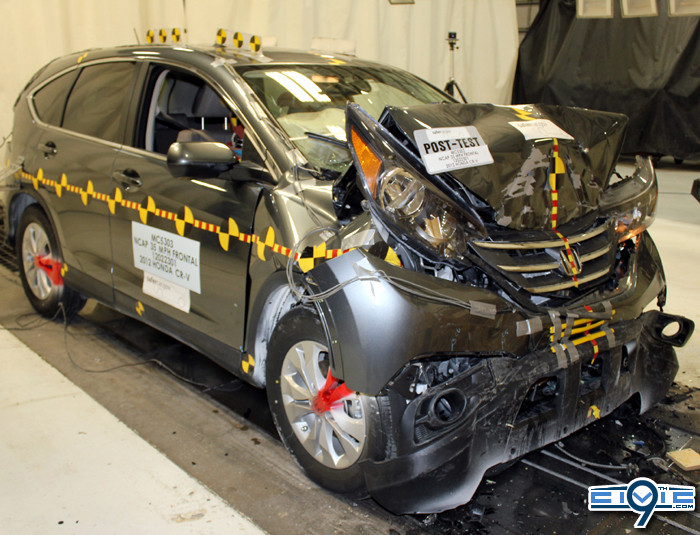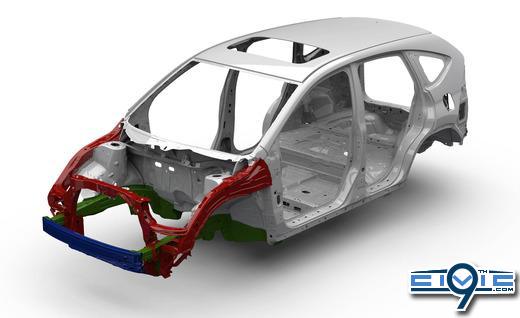- Staff
- #1
- 55,543
- 23,820
2012 Honda CR-V Earns 5 Star Crash Rating

The 2012 Honda CR-V has joined the latest list of cars earning a top five star crash rating. The CR-V lands a top spot among Honda's lineup of vehicles with the ACE body structure.

Similar to the previous-generation CR-V, an Advanced Compatibility Engineering™ (ACE™) body structure in the front of the vehicle helps make the vehicle highly effective at managing the energy of a frontal crash.
CR-V Safety Summary
Advanced Compatibility Engineering™ (ACE™) Body Structure
Following the lead of other Honda vehicles, the 2012 CR-V utilizes the latest version of the company's Advanced Compatibility Engineering (ACE) body structure technology to enhance occupant protection and crash compatibility in frontal collisions. The ACE design utilizes a network of connected structural elements to distribute crash energy more evenly throughout the front of the vehicle. This enhanced frontal crash energy management helps to reduce the forces transferred to the passenger compartment and can help to more evenly disperse the forces transferred to other vehicles in a crash. Additionally, ACE helps minimize the potential for under-ride or over-ride situations that can happen during head-on or offset frontal impacts with a larger or smaller vehicle.
Unlike most conventional designs that direct frontal crash energy only to the lower load-bearing structures in the front end, the ACE system actively channels frontal crash energy to both upper and lower structural elements, including the floor frame rails, side sills and A-pillars. By creating specifically engineered "pathways" that help distribute these frontal impact forces through a greater percentage of the vehicle's total structure, the ACE system can more effectively route them around and away from the passenger compartment to help limit cabin deformation and further improve occupant protection. Integral to the ACE concept is its unique front polygonal main design structure.

The 2012 Honda CR-V has joined the latest list of cars earning a top five star crash rating. The CR-V lands a top spot among Honda's lineup of vehicles with the ACE body structure.

Similar to the previous-generation CR-V, an Advanced Compatibility Engineering™ (ACE™) body structure in the front of the vehicle helps make the vehicle highly effective at managing the energy of a frontal crash.
CR-V Safety Summary
- Advanced Compatibility Engineering™ (ACE™) body structure
- Vehicle Stability Assist™ (VSA®) with traction control
- 4-wheel disc ABS, Electronic Brake Distribution (EBD) and Brake Assist
- Dual-stage, multiple-threshold front airbags, front-seat side airbags and side curtain airbags with rollover sensor
- Lower Anchors and Tethers for CHildren (LATCH) system in second-row outboard seats
- Pedestrian injury mitigation design in the front of the vehicle
Advanced Compatibility Engineering™ (ACE™) Body Structure
Following the lead of other Honda vehicles, the 2012 CR-V utilizes the latest version of the company's Advanced Compatibility Engineering (ACE) body structure technology to enhance occupant protection and crash compatibility in frontal collisions. The ACE design utilizes a network of connected structural elements to distribute crash energy more evenly throughout the front of the vehicle. This enhanced frontal crash energy management helps to reduce the forces transferred to the passenger compartment and can help to more evenly disperse the forces transferred to other vehicles in a crash. Additionally, ACE helps minimize the potential for under-ride or over-ride situations that can happen during head-on or offset frontal impacts with a larger or smaller vehicle.
Unlike most conventional designs that direct frontal crash energy only to the lower load-bearing structures in the front end, the ACE system actively channels frontal crash energy to both upper and lower structural elements, including the floor frame rails, side sills and A-pillars. By creating specifically engineered "pathways" that help distribute these frontal impact forces through a greater percentage of the vehicle's total structure, the ACE system can more effectively route them around and away from the passenger compartment to help limit cabin deformation and further improve occupant protection. Integral to the ACE concept is its unique front polygonal main design structure.

